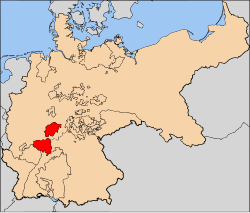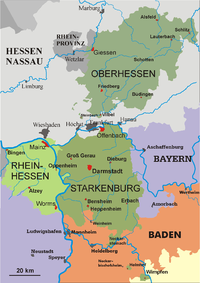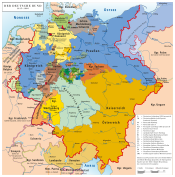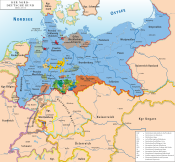Grand Duchy of Hesse
Grand Duchy of Hesse and by Rhine Großherzogtum Hessen und bei Rhein | |||||||||
|---|---|---|---|---|---|---|---|---|---|
| 1806–1918 | |||||||||
 Grand Ducal Hesse within the German Empire | |||||||||
| Capital | Darmstadt | ||||||||
| Government | Monarchy | ||||||||
| Grand Duke | |||||||||
• 1806–30 | Louis I | ||||||||
• 1830–48 | Louis II | ||||||||
• 1848–77 | Louis III | ||||||||
• 1877–92 | Louis IV | ||||||||
• 1892–1918 | Ernest Louis | ||||||||
| History | |||||||||
• Established | 13 August 1806 1806 | ||||||||
• German Revolution | 9 November 1918 1918 | ||||||||
| Area | |||||||||
| 1910[1] | 7,688.36 km2 (2,968.49 sq mi) | ||||||||
| Population | |||||||||
• 1910[1] | 1,282,051 | ||||||||
| |||||||||
The Grand Duchy of Hesse (‹See Tfd›German: Großherzogtum Hessen) was a member state of the German Confederation from 1806, when the Landgraviate of Hesse-Darmstadt was elevated to a Grand Duchy, until 1918, when all the German monarchies were overthrown. Before 1866, its northern neighbour was its former sister Landgraviate, since 1803 an Electorate, of Hessen-Kassel – for this reason, this state was sometimes known as Hesse-Darmstadt.
History
Due to Hesse-Darmstadt's membership of Napoleon's Confederation of the Rhine, it was forced to cede a considerable amount of territory at the 1815 Congress of Vienna. The territory of the Duchy of Westphalia, which Hesse-Darmstadt received from the 1803 German Mediatisation, was ceded to the Kingdom of Prussia. However, it received some territory on the western bank of the Rhine, including the important federal fortress at Mainz.

The Grand Duchy changed its name to the Grand Duchy of Hesse and by Rhine (‹See Tfd›German: Großherzogtum Hessen und bei Rhein) in 1816.
In 1867, the northern half of the Grand Duchy (Upper Hesse) became a part of the North German Confederation, while the half of the Grand Duchy south of the Main (Starkenburg and Rhenish Hesse) remained outside. In 1871, it became a constituent state of the German Empire. The last Grand Duke, Ernst Ludwig (a grandson of Queen Victoria and brother to Empress Alexandra of Russia), was forced from his throne at the end of World War I, and the state was renamed the Volksstaat Hessen (People's State of Hesse).
The majority of the state combined with Frankfurt am Main, the Waldeck area (Rhine-Province) and the former Prussian province of Hesse-Nassau to form the new state of Hesse following the Second World War. Excepted was the Montabaur district from Hessen-Nassau and that part of Hessen-Darmstadt on the left bank of the Rhine (Rhenish Hesse) became part of the Rhineland-Palatinate state. (Bad) Wimpfen - an exclave of Hessen-Darmstadt - became part of Baden-Württemberg, district of Sinsheim.
Transport
Because of the disjointed nature of the state, it did not develop its own state railway to begin with, but set up joint railway projects with its neighbouring states: These were the:
- Main-Neckar Railway with Frankfurt and Baden
- Main-Weser line with Frankfurt and Kurhessen
- Frankfurt-Offenbach Railway with the Free City of Frankfurt
In addition the state encouraged numerous other projects by the privately-owned Hessian Ludwig Railway Company. Finally, in 1876 the state founded its own company, the Grand Duchy of Hesse State Railways, which continued to expand the network until it was finally merged into the Prussian-Hessian Railway Company in 1897.
Subdivisions of Hesse

The Grand Duchy of Hesse was divided into three provinces:
- Starkenburg: (Capital: Darmstadt) Right bank of the Rhine, south of the Main
- Rhenish Hesse, (Capital: Mainz) Left bank of the Rhine, territory gained from the Congress of Vienna
- Upper Hesse (Capital: Giessen) North of the Main, separated from Starkenburg by the Free City of Frankfurt.
See also
External links
References
- 1918 disestablishments
- History of Hesse
- History of Rhineland-Palatinate
- History of Baden-Württemberg
- House of Hesse-Darmstadt
- States of the German Empire
- States of the North German Confederation
- States of the German Confederation
- States of the Confederation of the Rhine
- States and territories established in 1806






